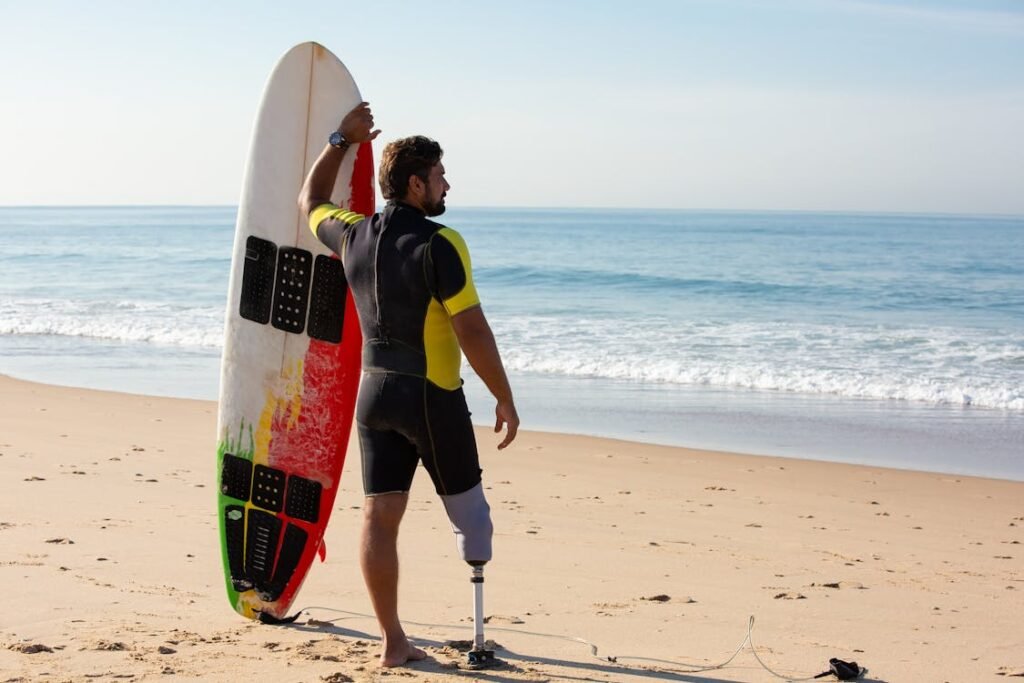Every step we take sends a little jolt through our legs. For someone using a lower-limb prosthetic, that jolt feels different — sometimes sharper, sometimes heavier, and often more tiring. It’s not just about walking or standing. It’s about comfort, balance, and long-term health. That’s where shock absorption comes in.
Shock absorption in prosthetics isn’t just a fancy feature. It’s the quiet hero that helps protect joints, reduce pain, and make movement feel smoother and more natural. Whether you’re walking in a park or climbing stairs, the right kind of shock absorption can change how your day feels.
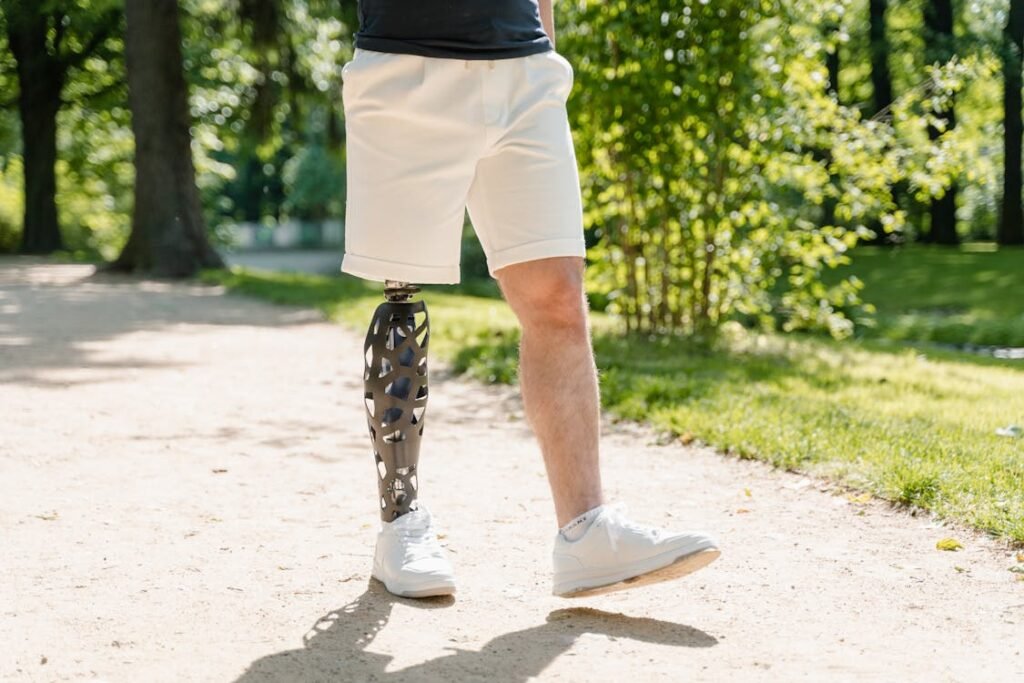
What Is Shock Absorption in Prosthetics?
Shock absorption, in the simplest terms, is the ability of a prosthetic to reduce the impact that happens when the foot hits the ground. For someone using a lower-limb prosthetic, every step brings a quick downward force.
Without anything to soften that impact, this force can travel up through the leg, putting stress on the joints and the rest of the body.
In a natural leg, bones, muscles, tendons, and ligaments all work together to manage this shock. The heel strikes the ground first, and the body naturally absorbs the energy with a mix of bending and soft tissue movement.
With a prosthetic limb, especially a below-knee or above-knee one, some of these natural shock absorbers are missing.
That’s why prosthetic designers use special parts, like springs and cushioned pylons, to try and mimic what the body used to do on its own.
The goal is to create smoother motion and reduce the impact. But it’s not only about comfort. Proper shock absorption can help prevent long-term wear and tear on the joints.
For someone with an above-knee prosthetic, for instance, the hip joint has to work harder to move the leg forward.
If there’s no shock absorption, the hip takes the full brunt of that ground reaction. Over time, that leads to pain and even damage.
The Difference It Makes in Daily Life
The benefit of shock absorption isn’t just mechanical — it’s deeply personal. It’s the difference between finishing the day with sore hips and knees or feeling strong and balanced.
It means less fatigue, more energy, and a smoother walking experience. For users who enjoy running, trekking, or even just walking long distances, the role of shock absorption becomes even more important.
Shock-absorbing elements also help with stability. When the impact is softened, the rest of the body doesn’t have to react as quickly or as harshly.
That leads to better control, especially for people who are still learning to walk with their prosthetic or going through rehabilitation.
In India, where diverse terrain, uneven pavements, and varied weather conditions are common, the way a prosthetic absorbs shock can directly affect mobility.
Walking across cobbled streets or climbing stairs requires more than just strength — it needs smart design that supports the body every step of the way.
How Prosthetics Handle Shock Today
Modern lower-limb prosthetics use different methods to handle shock. Some models have vertical shock pylons that compress slightly on impact.
These pylons often include built-in springs or rubber materials that absorb the energy and then release it as the person moves forward.
Others have torsion adapters that twist slightly to absorb the twisting motion of the leg, especially when turning or walking on uneven ground.
There are also advanced feet made with carbon fiber or composite materials. These aren’t just lightweight — they flex and store energy, just like tendons in a real foot.
When the foot hits the ground, it bends slightly and then springs back, pushing the user forward.
All of this might sound technical, but the real question is simple: how does it feel to walk in it? The answer often depends on how well the prosthetic handles shock.
If a user feels like they’re walking on a hard board, it means the shock isn’t being managed well. But if they feel supported and smooth in motion, the shock-absorbing elements are doing their job right.
It’s important to remember that not every person needs the same kind of shock absorption. What works for a young athlete might not be right for an elderly person.
Choosing the right design means understanding how that person moves, what their daily life looks like, and how their body responds to different surfaces.
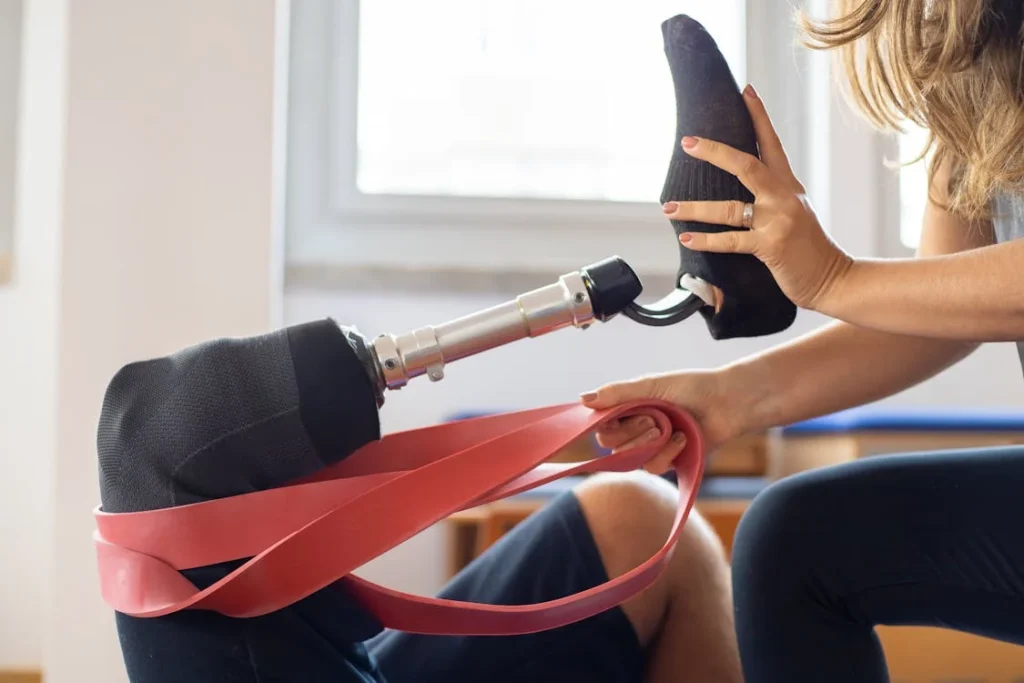
The Science Behind Impact and Human Movement
What Happens When the Foot Hits the Ground
When a person walks, runs, or jumps, their body has to deal with something called ground reaction force. This is the force that pushes back up against the body every time the foot touches the ground.
In a natural leg, this force is absorbed by the heel pad, the ankle joint, the muscles, and the knee. They all work together like a suspension system in a car. The impact is spread out and softened.
But when someone has a lower-limb amputation, especially below or above the knee, a part of that suspension system is no longer there.
The prosthetic has to take over this job. If it doesn’t, that force goes straight into the residual limb, the socket, and the rest of the body. That leads to stress, pain, and even long-term injuries.
Shock absorption in prosthetics is all about managing this force. A good design will reduce the peak impact and spread it over a longer time.
This means the body doesn’t get hit with a sudden jolt. Instead, it gets a more gentle push, which is easier to manage.
Why Energy Matters in Motion
Every time we move, we’re dealing with energy — using it, storing it, and releasing it. The human body is designed to use this energy smartly.
When we land on our foot, some energy is absorbed and then pushed forward to help with the next step. This is called energy return, and it’s part of what makes walking efficient.
Modern prosthetics try to do something similar. Materials like carbon fiber are used because they can bend and then return to their original shape, giving that bounce-forward feeling.
But to do this well, the limb has to absorb the shock first. Without proper shock absorption, all that energy just gets lost or turns into pressure, which the body feels as pain.
This is why shock absorption isn’t just a nice feature — it’s part of making a prosthetic that supports long-term mobility. It keeps people walking longer, with less pain and more confidence.
How the Body Reacts Without Proper Shock Absorption
When a prosthetic doesn’t absorb shock well, the body starts to compensate in ways that aren’t healthy. The hip might start working harder, leading to soreness.
The back might try to adjust, causing strain. Over time, this affects posture and balance.
Users often develop habits like leaning to one side or swinging the leg out to avoid discomfort. These habits might work short term, but they put more stress on the rest of the body.
That’s why getting the shock absorption right from the beginning is so important. It helps create a natural gait, reduces strain, and supports healthier movement patterns.
It’s also a matter of emotional well-being. Walking should feel easy and natural. When each step feels like a fight, it affects confidence.
People become hesitant to move, which leads to less activity and even isolation. Good shock absorption removes one more barrier between the user and a fuller, more mobile life.
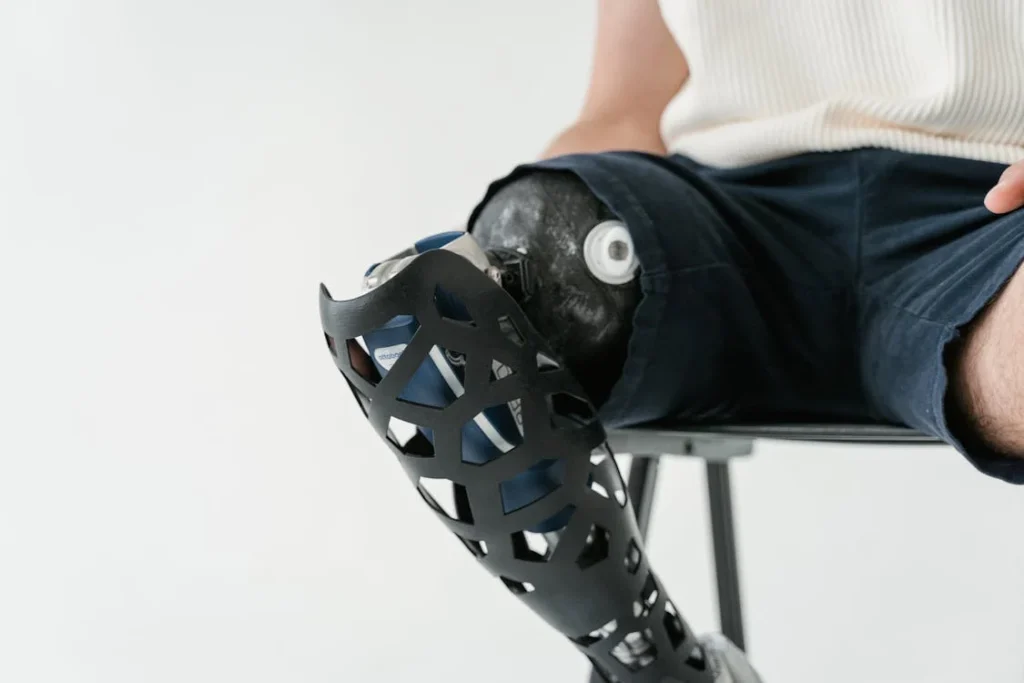
Types of Shock-Absorbing Designs in Lower-Limb Prosthetics
Pylon Systems and Their Role in Shock Control
One of the most common parts where shock absorption is built into a prosthetic is the pylon, which is the connecting tube between the socket and the foot.
Think of the pylon like the frame of a bicycle—it holds everything together, but it can also be designed to do more than just connect parts.
Some pylons are rigid and don’t absorb much shock. These can feel stiff and harsh on harder surfaces. But others are designed to flex slightly or compress a little under pressure.
These pylons are usually built with springs or soft inner materials that cushion each step. As the user walks, the pylon takes in some of the energy and then gently lets it go. This keeps the limb from feeling too rigid and helps with smoother motion.
For users who walk a lot on uneven surfaces, such as rural roads, or need to climb stairs daily, a flexible or shock-absorbing pylon can make everyday activities much easier on the joints.
Foot Systems and Energy Storage
The foot of the prosthetic plays a huge role in both shock absorption and energy return. Many modern feet are made from layered materials like carbon fiber, which can bend slightly when pressure is applied.
When the foot hits the ground, it flattens just a little. That bending stores energy. Then, as the user lifts the foot for the next step, the material returns to its original shape and releases the energy, pushing them forward.
This is especially important for users who are active, as it makes walking feel more natural and less tiring. It also helps create a smoother step, which reduces the impact on the residual limb.
A good foot design can even reduce how much force travels upward through the rest of the prosthetic, lowering the stress on hips, knees, and the spine.
Different foot designs offer different levels of flexibility. Some are stiffer, made for users who need a lot of stability.
Others are more dynamic and flexible, better for users who walk long distances or move quickly. The right match depends on the user’s lifestyle, strength, and mobility goals.
Torsion Adapters for Twist and Turn Movements
Walking in a straight line is just part of daily movement. We also turn, pivot, and adjust our direction constantly.
For someone using a prosthetic, these small twisting movements can put extra pressure on the limb, especially if the prosthetic doesn’t allow for that kind of motion.
Torsion adapters are small parts added to the prosthetic that let it twist slightly when the user turns. This twisting action helps absorb the rotational force that comes from pivoting, especially on uneven surfaces or while changing directions.
Without this, that force gets absorbed by the skin, socket, and residual limb, which can lead to discomfort and even skin damage over time.
Torsion features are especially helpful for active users or anyone who needs to move quickly and often.
Even in daily tasks like walking across a busy street or stepping onto a bus, that slight twist in motion matters. The smoother it is, the more confident the user feels.
Socket Design and Comfort Padding
While most people focus on the foot and pylon for shock absorption, the socket—the part where the prosthetic connects to the body—is just as important.
A well-fitted socket doesn’t just hold the limb in place. It also helps manage how the forces from walking get distributed across the residual limb.
Some sockets include soft liners or pads that reduce direct pressure. These help spread the impact over a larger area, which protects sensitive parts of the skin.
Others use materials that slightly compress when the user walks, adding a bit of cushioning that works with the rest of the prosthetic system.
Comfort in the socket is often the difference between using a prosthetic confidently and avoiding it due to pain.
Shock absorption at this level isn’t about springs or high-tech parts—it’s about design that considers how the human body responds to pressure and movement.
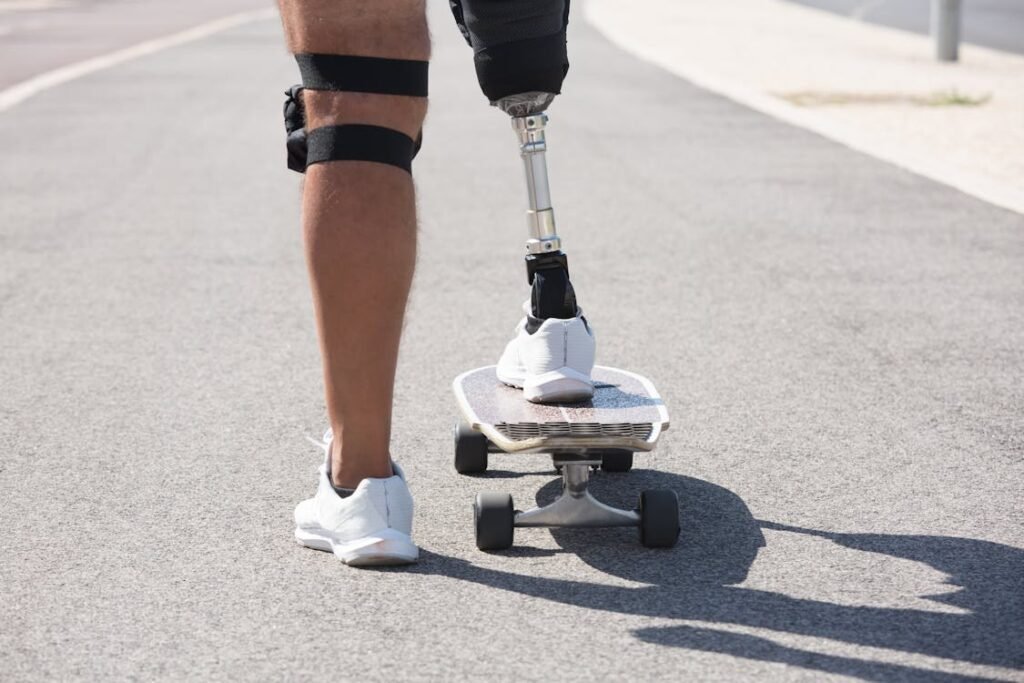
Choosing the Right Shock Absorption: What Really Matters
Understanding the User’s Lifestyle
One of the most important things to consider when designing or selecting a lower-limb prosthetic is how the person plans to use it. Not everyone walks the same way or lives in the same kind of environment.
A farmer walking on rough, uneven paths in a village will need something very different from an office worker navigating smooth floors all day.
Shock absorption needs to match this lifestyle. If someone spends most of their day walking long distances or standing, a prosthetic with good vertical shock control will help reduce fatigue.
On the other hand, someone who needs more balance and less movement may not need the same level of flexibility, but may benefit more from a stable, cushioned socket and controlled foot roll.
Understanding daily habits, work responsibilities, and even hobbies helps guide these choices. The more the prosthetic matches the person’s life, the more it feels like part of them—not just a tool they have to work around.
Activity Level and Energy Return
Another key factor is how active the person is. This doesn’t mean whether they play sports or not, but how much they move each day. Some people walk short distances indoors.
Others may need to walk to the bus stop, take stairs regularly, or run short errands on foot. For these people, the prosthetic has to not only absorb shock but also return some of that energy to help with the next step.
Prosthetics designed for higher activity levels often use more advanced materials like composite fibers, which offer both cushioning and bounce.
These designs feel lighter and smoother during fast movement. For users who are older or have balance concerns, however, a more stable system that focuses on shock reduction without too much movement may feel safer and more supportive.
Body Weight and Height
Shock travels differently through bodies of different shapes and sizes. A heavier person puts more pressure on the prosthetic, so the system has to absorb a greater amount of force.
Taller users may need longer pylons or custom alignment to manage how shock flows through their body. A prosthetic that works well for one person might feel stiff or unstable for another just because of this difference in body mechanics.
That’s why prosthetics need to be fitted and adjusted with care. It’s not only about the limb length or foot size—it’s about understanding how the whole body works together, and making sure the prosthetic supports that.
The Surface Matters Too
It’s easy to forget that the ground we walk on affects how shock moves through the body. A person who walks mostly on soft grass or earth won’t need as much built-in shock control as someone who walks on concrete every day.
In urban areas, hard surfaces are common. Each step sends a stronger force up through the limb.
That’s why shock-absorbing feet and flexible pylons are especially useful for city dwellers. In more rural or mixed-terrain settings, a blend of features works best—something that handles both soft and hard surfaces without too much bouncing or sliding.
In India, where pavements can change from smooth tiles to broken stone within just a few steps, having adaptive shock absorption becomes even more important.
The prosthetic should adjust to different conditions without needing constant adjustment from the user.
Comfort First, Always
No matter how advanced the materials are or how well the parts absorb impact, the prosthetic needs to feel good to use. Comfort is not just about avoiding pain—it’s about making the user feel confident, supported, and balanced.
Sometimes, users avoid walking too much because they expect discomfort. Over time, this leads to muscle weakness and less independence.
A prosthetic that handles shock well removes that barrier. It encourages movement, helps build strength, and supports emotional well-being. When the user feels secure in each step, they’re more likely to explore, engage with others, and live more fully.
Every person’s body is different. That’s why fittings must be personal. They must be done by professionals who understand both the technical and human side of mobility.
When shock absorption is tailored just right, it becomes invisible. The user doesn’t think about it—they just walk, move, and live.
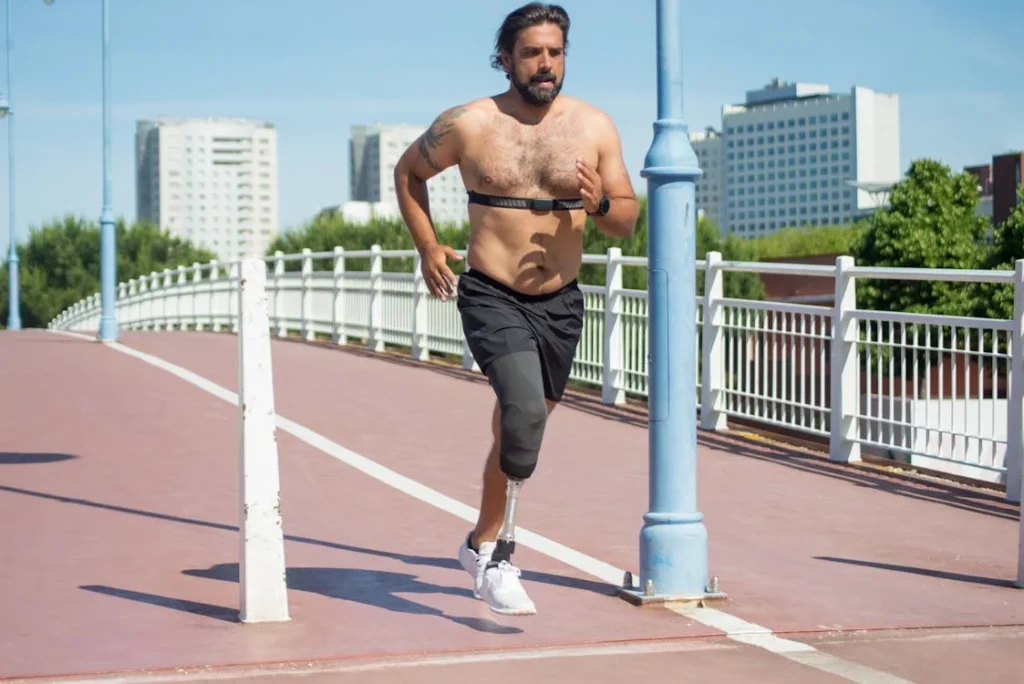
Long-Term Impact of Shock Absorption on Health
Joint Protection Over Time
When a prosthetic does not absorb shock properly, the body has to deal with the extra force. This is often subtle at first.
A user may not feel much difference on day one or even week one. But over months and years, this pressure adds up. The hip, knee, and lower back begin to show signs of wear.
Users without proper shock absorption often report aches, stiffness, or soreness, especially after long days. In the long term, this strain can lead to chronic pain, joint degeneration, and even conditions like arthritis.
The joints are constantly exposed to repetitive force that they weren’t built to manage alone.
Good shock absorption works like a cushion between the body and the ground. It takes the hit so the joints don’t have to.
It spreads out the force, so instead of hitting one area hard, it gets distributed across the system in a way the body can handle.
This isn’t just about comfort today. It’s about preserving the health of the body for years to come. A prosthetic that protects the joints helps ensure that the user stays active longer and avoids preventable injuries or conditions.
Balance and Posture Benefits
Posture and balance are deeply connected to how the body absorbs shock. When one side of the body gets more impact than the other, users start to shift their weight or move differently to avoid discomfort.
These adjustments might help in the moment, but they create long-term problems.
Over time, users develop an uneven gait. One shoulder might dip lower, the back might arch unnaturally, or the user might walk with a swing or limp.
This uneven motion uses more energy and puts stress on muscles and bones that weren’t meant to carry that load.
Proper shock absorption makes it easier for the body to stay aligned. It helps the user keep their head, spine, and limbs in balance.
That leads to a more natural walk and reduces the risk of falling, twisting, or getting injured. It also lowers fatigue, since the user doesn’t need to spend extra energy correcting poor posture all day.
Mental and Emotional Health
When walking is painful or uncomfortable, it’s not just the body that suffers. Many users describe feeling nervous, hesitant, or frustrated when they walk. This anxiety limits how much they move or how freely they engage with others.
Shock absorption might seem like a small part of the prosthetic, but it plays a big role in restoring confidence.
When a user feels the ground absorb gently beneath their foot, rather than striking up through the socket, they move with more ease.
This sense of comfort encourages regular activity, which in turn improves mental well-being.
The ability to move without fear or hesitation can have a deep emotional impact. It brings back freedom, reduces stress, and supports social connection.
It lets people return to daily routines, hobbies, or even dreams they thought they’d left behind.
Support During Rehabilitation
Rehabilitation is one of the most important stages in prosthetic use. It’s when the user learns how to move again, builds strength, and gets used to the new limb.
During this period, the body is adjusting, and the muscles are still adapting to new demands.
Without proper shock absorption, this phase becomes much harder. The body feels each impact more strongly, which can slow down progress or even cause injury.
On the other hand, shock-absorbing features help reduce pain and make walking less tiring. This means users can train for longer periods, make better progress, and gain confidence faster.
Gamified rehabilitation programs, which are growing in popularity, also benefit from well-designed prosthetics. These programs rely on repeated movement and active feedback.
When the prosthetic is comfortable and responsive, the user engages more. It feels less like exercise and more like discovery.
At Robobionics, we’ve seen firsthand how better shock absorption leads to better outcomes. It supports users during their hardest moments and makes the road to recovery smoother and more successful.
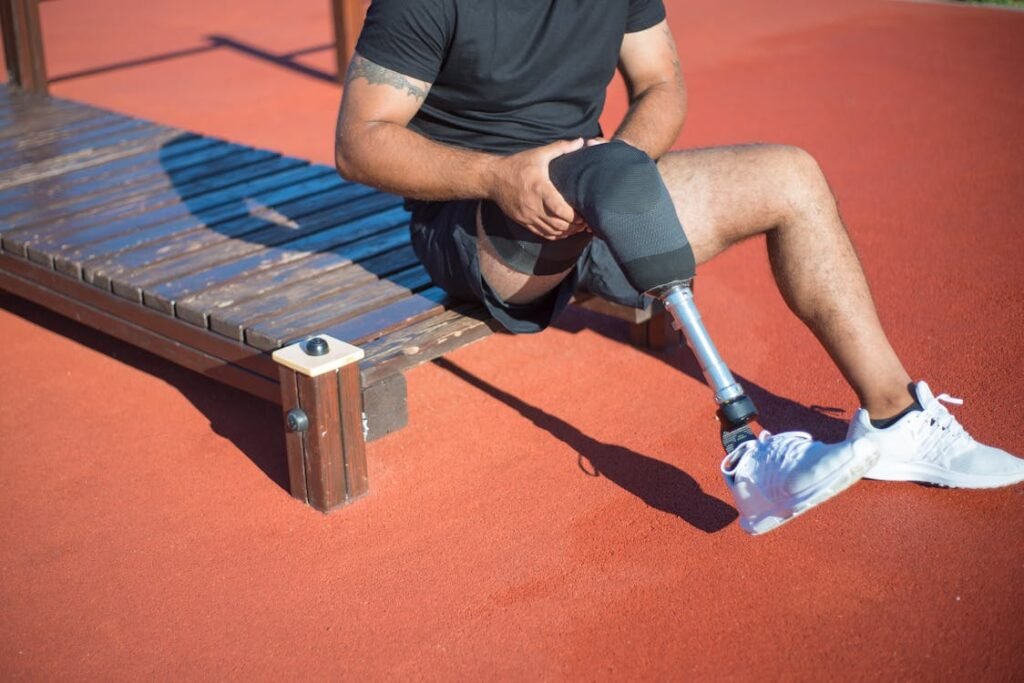
The Future of Shock Absorption in Lower-Limb Prosthetics
Smart Materials and Responsive Systems
One of the most exciting advancements in prosthetics is the use of smart materials. These are materials that can adapt in real-time to movement, temperature, or pressure.
Imagine a prosthetic foot that stiffens when walking uphill to give more support, but softens on flat ground to make each step smoother. That’s what smart materials are aiming to do.
Instead of relying only on springs or rubber, future prosthetics may use materials that respond like real tissue. These systems can detect how much force is being applied and change their shape or tension instantly.
This kind of responsive technology can create a smoother, more intuitive walking experience—almost like getting your own muscles and joints back.
Some prototypes already include sensors that measure how a person walks and then automatically adjust the shock absorption system to suit the moment.
Whether stepping onto a soft carpet or a hard concrete road, the prosthetic adjusts to keep the body comfortable and stable.
Integration with Microprocessors
Microprocessor-controlled prosthetics are becoming more common, especially for above-knee users.
These devices use sensors and tiny computers to analyze walking patterns in real-time. When paired with shock absorption systems, they can offer a new level of control.
For instance, if the system senses that the user is walking faster, it can adjust the stiffness of the joint or pylon to improve energy return.
If the terrain changes—like stepping onto a slope or climbing stairs—the shock absorption can change to protect the user’s joints and improve grip.
This level of adaptability allows for more natural movement and helps the prosthetic respond to the body, instead of the other way around.
These changes reduce the amount of mental focus needed to walk smoothly, freeing up the user to think about where they’re going instead of how they’re getting there.
Lightweight Designs with Better Impact Control
As materials improve, prosthetics are getting lighter. But being lightweight doesn’t mean giving up on strength or shock control.
In fact, many modern materials, like carbon fiber and advanced polymers, are strong enough to handle the force of walking or running while being incredibly light.
This shift helps users move more freely. Less weight means less effort is needed to swing the leg forward or maintain balance.
When paired with good shock-absorbing design, these materials also reduce strain on the back and hips.
Prosthetic feet are being redesigned to handle multiple shock-related functions at once—absorbing vertical impact, controlling twist, and supporting energy return—all in a slim, low-profile structure. This means more comfort, better performance, and a look that feels modern and sleek.
Personalized Fit Through 3D Printing
One of the biggest challenges in prosthetics has always been fit. A socket that doesn’t sit just right can ruin the experience, no matter how good the shock absorption is elsewhere. That’s why 3D printing is such a game-changer.
With 3D scanning and printing, the socket and other parts of the prosthetic can be shaped to fit the user exactly. No more adjusting standard sizes.
This means a better connection between the limb and the prosthetic, which helps with stability and reduces pressure points.
But that’s not all—3D printing also allows for customizable shock-absorbing structures. Designers can build patterns inside the pylon or foot that act like springs, soft zones, or twisting elements, all fine-tuned to the user’s body and activity level. It brings precision to a space where comfort is everything.
Making Technology Accessible
The future of shock absorption isn’t just about high-end features—it’s about making those features available to everyone.
In many parts of the world, especially across India, users need affordable, durable, and reliable prosthetics that can handle real-life conditions.
Innovations in local manufacturing, open-source designs, and smart material sourcing are helping bring advanced prosthetics to more people.
Instead of waiting months for imports, users can now access modern solutions faster and at lower costs. These solutions often outperform imported options, especially when it comes to service and fit.
At Robobionics, we’ve made it a priority to design and produce locally, using technologies that don’t just match international standards—they’re tailored to Indian needs.
The goal is simple: better shock absorption, better comfort, and a better life for every user.
Conclusion
Shock absorption in lower-limb prosthetics isn’t just about comfort—it’s about protecting the body, improving balance, and making every step feel more natural. Whether someone is walking to work, climbing stairs, or playing with their kids, the right kind of shock-absorbing design makes all the difference.
From cushioned pylons and dynamic feet to personalized sockets and smart materials, today’s innovations are helping users move better and live more fully. It’s not about high-tech for the sake of it—it’s about giving people the freedom to move with less pain, more stability, and greater confidence.
At Robobionics, we believe that prosthetics should feel like a part of you, not a piece of equipment you have to manage. With thoughtful design, local expertise, and user-first innovation, we’re working to make that belief a reality—step by step.



